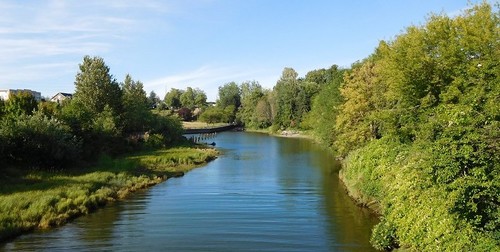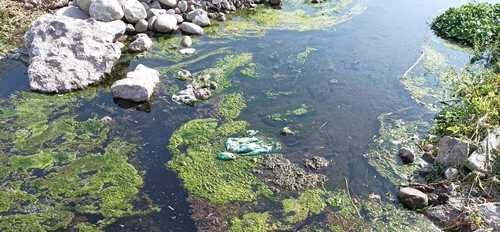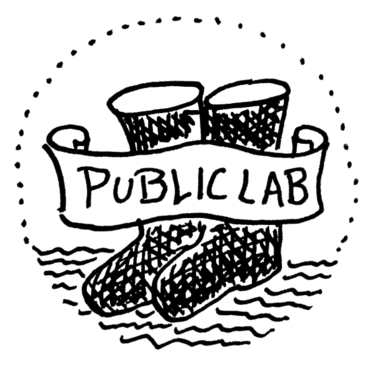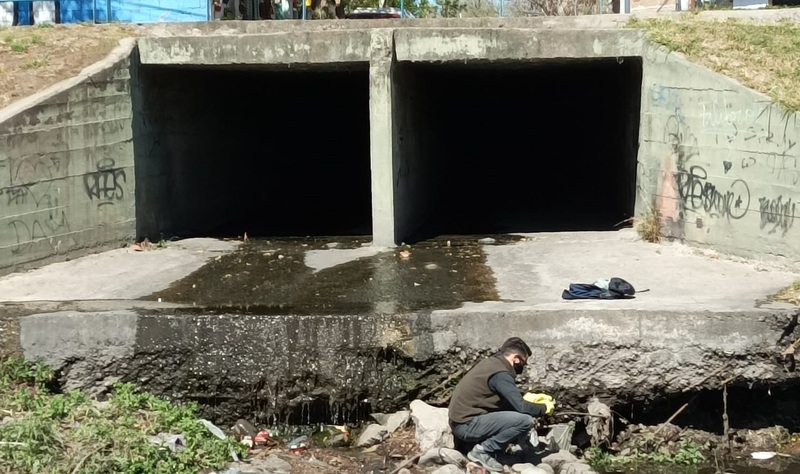
Wastewater
Where does water go once it flows down the sink drain? What about the water trickling down the street into storm drains? Or water discarded from industrial activities?
Wastewater is “used water” that’s created by households, cities, and industry. It’s most commonly associated with sewage, but we can also talk about surface runoff and stormwater that flows from roadways into storm drains. In any case, wastewater and stormwater eventually end up in the environment.
Because wastewater can come from many different sources, it can contain a variety of pollutants—soaps and personal care products, sanitary waste, pesticides and fertilizers, and fuel, to name a few. Industrial processes might produce wastewater laced with heavy metals or heated so hot that it harms living things nearby.
On this page we’ll collect and organize resources on wastewater and how people can begin to investigate it. Visit the wastewater tag page to see the latest community posts about wastewater on Public Lab, and get updates on this topic by following:
Sources: Wastewater pollution
Lead image: @alejobonifacio sampling along the Suquía River near a wastewater treatment plant.
See community stories and projects on wastewater
Join the conversation- Ask a question, answer a question, or follow future questions on wastewater
- Post an issue brief that describes your local concern about wastewater
- Get started with observing and documenting wastewater pollution
- Learn more about wastewater and how people can be exposed to it
- Learn about different ways to monitor wastewater
- Do or add an activity
Learn about regulations for wastewater and what community members can do
Find further reading and resources on wastewater
See next step challenges in wastewater community science and method development
Community stories and projects
Public Lab community projects tagged with wastewater-project will appear here
You can also find stormwater-related projects here: https://publiclab.org/wiki/stormwater#Project+Pages
Join the conversation
Questions from the community
- See if other community members are asking questions like yours
- Ask a question so other community members can offer support
- Sign up below to be notified when someone asks a wastewater-related question
Questions tagged with question:wastewater will appear here
| Title | Author | Updated | Likes | Comments |
|---|---|---|---|---|
| What are health and environmental concerns for sewage smell in a home? | @stevie | almost 3 years ago | 1 | 3 |
| What are some observable tell-tale signs of wastewater pollution? | @bhamster | over 3 years ago | 1 | 11 |
| Who do you contact on stormwater concerns? | @stevie | over 6 years ago | 0 | 2 |
| What are sources of stormwater pollution? | @stevie | over 6 years ago | 0 | 2 |
| How is stormwater regulated? | @stevie | almost 8 years ago | 0 | 4 |
Post an Issue Brief
Share a local concern or issue about wastewater pollution and get support from the Public Lab community by writing and posting an Issue Brief. Visit “Write an Issue Brief” to find information on what an issue brief is, see examples, and learn how to write one.
Research wastewater
Image: @warren
The Public Lab community is here to support people as they plan and carry out investigations into local wastewater pollution. Anyone can ask questions, start an issue brief with any amount of information available, or start documenting a project.
Some places to start
Here are some activities you might want to try when starting to research wastewater pollution.
How to report pollution entering your local stormwater system in the US
Post by @bhamster 5 | over 3 years ago
Post your photos of possible wastewater pollution! / ¡Postea tus fotos de aguas posiblemente residuales! 📷
Post by @bhamster 2 | over 3 years ago
How to find out if waterbodies near you in the US are healthy or impaired
Post by @bhamster 0 | over 3 years ago
Information on wastewater pollution
Sewer systems and how people get exposed to wastewater
In cities and towns in the US, you’ll mostly find two different kinds of sewer systems that collect and transport wastewater: combined sewer systems and separate sewer systems.
Combined sewer systems collect both stormwater runoff from storm drains AND raw sewage from buildings and households. The stormwater and sanitary sewage are both directed in a single pipe to a wastewater treatment plant to be cleaned. When there are heavy rains, however, this increases the amount of stormwater flowing into the combined system. Not all the extra incoming water can be handled by the wastewater treatment plant, and so the rest is released directly into the environment as a Combined Sewer Overflow (CSO), raw sewage and all.
In New York City, for example, about 60% of the city is served by a combined sewer system.
Separate sewer systems have, as one might guess, separate pipes for stormwater and sanitary sewage. Many stormwater systems in the US are Municipal Separate Storm Sewer Systems (MS4) that have to follow regional and federal permit regulations to reduce water pollution. In most cases, though, the stormwater isn’t fully treated before it gets released into the environment.
A separate sanitary sewer system transports raw sewage from households, businesses, and other buildings to a wastewater treatment plant. There, the sewage is treated and the cleaned water is released into the environment.

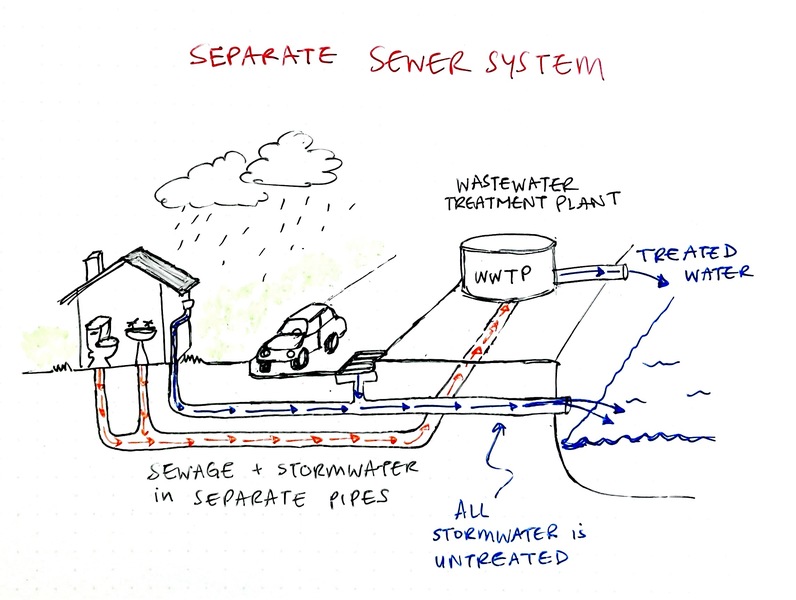
With any kind of sewer system, there’s the threat of exposing people to wastewater. Untreated or under-treated wastewater can make its way into waterbodies that people use for recreation, fishing, or drinking water. Pollutants can also become airborne when wastewater enters coastal areas. The wastewater might be legally released under a permit, it might be illegally dumped, or it might leak from broken pipes and other sewer system infrastructure.
Wastewater pollutants
- Common water contaminants: wiki with info on contaminant, potential sources, methods, and how to address the problem
Methods to monitor wastewater
Detecting possible wastewater pollution
Lots of information (in English and Spanish) about what to look for in the comments of this question: What are some observable tell-tale signs of wastewater pollution?
Check out the wiki page below on different methods for detecting wastewater pollution:
On that page, you’ll find information on monitoring some water quality characteristics that could indicate wastewater pollution:
- Water color or clarity
- Odor
- Water temperature
- Conductivity
- Indicator chemicals or components
Activities
Activities on Public Lab that have been tagged with activity:wastewater will appear here
| Purpose | Category | Status | Author | Time | Difficulty | Replications |
|---|---|---|---|---|---|---|
| ¿Cómo evaluar la calidad de un río con insectos acuáticos (bioindicadores)? / How do I assess the quality of an river with aquatic insects (bioindicators)? | - | - | @alejobonifacio | - | - | 0 replications: Try it » |
| ¿Cómo detectar abrillantadores ópticos (aguas residuales) yendo a un río? / How to detect optical brighteners (wastewater) going to a river? | - | - | @alejobonifacio | - | - | 0 replications: Try it » |
| ¿“Pelo” gris en el agua ríos y arroyos? | - | - | @alejobonifacio | - | - | 0 replications: Try it » |
| How to find out if waterbodies near you in the US are healthy or impaired | observe | - | @bhamster | 30m | easy | 0 replications: Try it » |
| Did you see gray “hair” in the bottom of freshwater bodies? | - | - | @alejobonifacio | - | - | 0 replications: Try it » |
| How to report pollution entering your local stormwater system in the US | - | - | @bhamster | - | - | 0 replications: Try it » |
Activities should include a materials list, costs and a step-by-step guide to construction with photos. Learn what makes a good activity here.
Regulations, policy, and advocacy
US federal regulations
- National Pollutant Discharge Elimination System (NPDES), part of the US Clean Water Act: under the NPDES program, “EPA regulates discharges of pollutants from municipal and industrial wastewater treatment plants, sewer collection systems, and stormwater discharges from industrial facilities and municipalities” (from EPA website)
- Read more about the NPDES regulations here: https://publiclab.org/wiki/npdes
- What’s news: “EPA announces intent to strengthen limits on water pollution from power plants,” from Water & Wastes Digest, July 2021.
State and local regulations
- Information about wastewater discharge and stormwater regulations in Colorado on the Colorado Regulations Hotsheet
- Hudson Riverkeeper teaches how to report Gowanus pollution, by @liz
- What’s news: Washington State Department of Ecology is drafting up a general permit to limit nutrients that domestic wastewater treatment plants release into Puget Sound. Nutrients like phosphorous and nitrogen come to treatment facilities in household wastewater, and too much negatively impacts water quality.
International regulations
Please share more here!
Advocacy
In general, how can community members take action on wastewater pollution?
I asked an environmental planner, “What do you want people to know about stormwater?”
Post by @bhamster 0 | 3 years ago
How to report pollution entering your local stormwater system in the US
Post by @bhamster 5 | over 3 years ago
Post your photos of possible wastewater pollution! / ¡Postea tus fotos de aguas posiblemente residuales! 📷
Post by @bhamster 2 | over 3 years ago
How to find out if waterbodies near you in the US are healthy or impaired
Post by @bhamster 0 | over 3 years ago
Further reading and resources
- Wastewater basics 101 slide presentation from the US EPA (it’s pretty technical)
- Greater Lansing Regional Committee for Stormwater Management website has tons of information about stormwater and what community members can do to reduce pollution entering storm sewer systems.
Wikis
Wiki pages related to wastewater
| Title | Updated | Version | Views | Likes | |
|---|---|---|---|---|---|
| Wastewater | about 3 years ago by bhamster | 2 | 282 | 0 | |
| Detecting wastewater pollution | about 3 years ago by bhamster | 3 | 484 | 2 | |
| NPDES | almost 8 years ago by warren | 17 | 984 | 0 |
Next step challenges
- Collectively create a “hotsheet” of local/regional stormwater pollution reporting numbers
- Spectrometry methods for wastewater:
- Determining spectral signatures of wastewater pollution so different forms of contamination can be detected in real time with a DIY spectrometer
- There are some developments on spectrometry methods linked here on the detecting wastewater pollution wiki
- Modifying spectrometers:
- Modifying a DIY spectrometer into a fluorometer for detecting optical brighteners in stormwater outfalls (possibly as a follow up to this activity?)
- Modifying a DIY spectrometer into a luminometer for measuring light output from bio- or chemiluminescence assays of sampled water.
- Bioindicators and biological tests of wastewater:
- Replicate this activity on counting aquatic invertebrates as indicators of water quality, test it at different sites.
- Develop and test a DIY bioluminescence inhibition assay on wastewater samples
- Methods that help enable recycling of biosolids that result from wastewater treatment:
- At wastewater treatment facilities, identifying and isolating harmful chemicals that won’t break down and would otherwise end up back in the environment from biosolids recycling. For example, PFASs (per- and polyfluoroalkyl substances), commonly used to make surfaces nonstick or water repellent. (Idea from @jesseslone)


